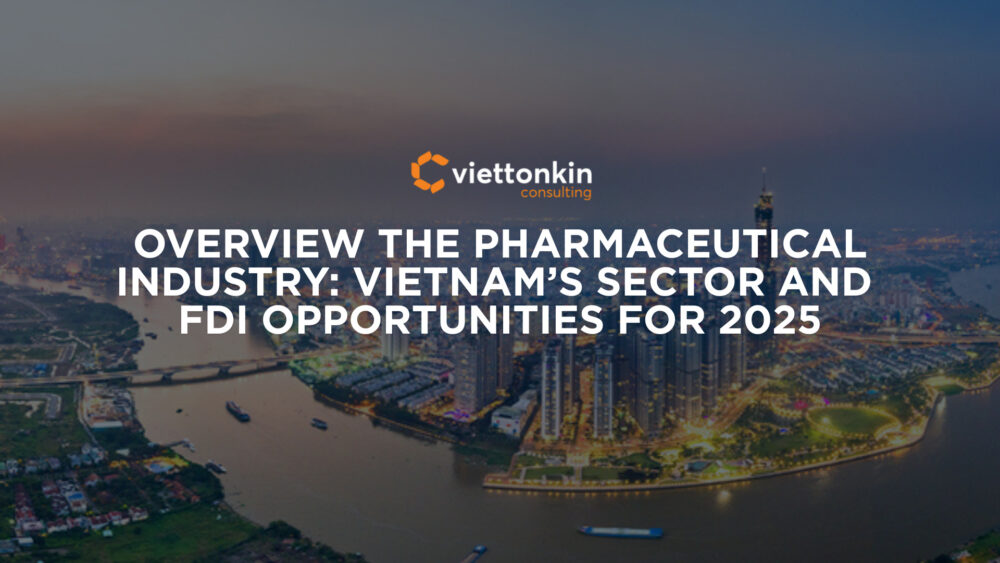Vietnam is rapidly establishing itself as a key player in the global pharma industry, evolving into a critical hub for global health and pharmaceutical manufacturing. Vietnam is also positioning itself to meet global demand for pharmaceuticals by leveraging its manufacturing upgrades and export-oriented policies, ensuring its supply chain can serve international markets. As one of […]
Vietnam is rapidly establishing itself as a key player in the global pharma industry, evolving into a critical hub for global health and pharmaceutical manufacturing. Vietnam is also positioning itself to meet global demand for pharmaceuticals by leveraging its manufacturing upgrades and export-oriented policies, ensuring its supply chain can serve international markets.
As one of the most promising emerging markets, its pharmaceutical sector is attracting significant FDI flows, driven by post-pandemic drug development priorities and a surge in domestic demand. This landscape is underscored by a projected market value surge from USD 7.3 billion in 2022 to an estimated USD 16.1 billion by 2026.
Key Takeaways:
- Robust Market Growth: Vietnam’s pharmaceutical market is projected to reach USD 16.1 billion by 2026, driven by a stable compound annual growth rate (CAGR).
- Manufacturing Upgrades are a Top Priority: There is a clear race among domestic manufacturers to upgrade facilities to EU-GMP standards to compete with imported brand name drugs and boost exports.
- The Ethical (ETC) Channel (drug distribution through hospitals) Dominates: The ETC channel, which includes many prescription drugs, accounts for up to 76% of industry revenue, fueled by national health insurance policies and tender preferences for locally produced drugs.
- Vibrant M&A Activity: Multinational corporations are actively acquiring controlling stakes in local firms to leverage existing distribution networks and pharmaceutical production capabilities.
- Supportive Government Policies: A national strategy aims for 80% of domestic drug demand to be met by local production by 2030, creating a favorable environment for FDI.
Vietnam's Pharmaceutical Industry and Market Structure

Vietnam’s pharmaceutical sector is on a remarkable growth trajectory, powered by a combination of economic expansion, policy stability, and favorable demographics. Investors view it as a strategic gateway to the broader ASEAN healthcare market.
The sector is increasingly integrated with regional health systems, supporting access to essential medicines and improved healthcare outcomes.
Industry Growth and Global Health Context
The expansion of Vietnam’s pharmaceutical industry is intrinsically linked to the regional healthcare landscape. According to a report by DMSpro (2025), in 2024, the market is among the fastest-growing globally, with a projected real CAGR of 6–8% during the period 2023 -2028. According to statistics, 66.6% of businesses are optimistic about the Vietnamese pharmaceutical industry market in 2025.
This growth in the healthcare system is supported by rising per capita spending on pharmaceuticals and a more health-conscious population in the wake of the pandemic. Rising healthcare costs are also shaping pharmaceutical spending patterns and influencing the growth trajectory of the industry.
Pharmaceutical Manufacturing and Good Manufacturing Practice (GMP)
Vietnam’s manufacturing foundation is solid, with 228 WHO-GMP certified factories nationwide. However, the real opportunity lies in upgrading to higher standards of Good Manufacturing Practice (GMP).
Currently, only 19 facilities are EU/PICs/Japan-GMP compliant or equivalent standards, creating a significant gap for foreign investors to invest in drive technology and process modernization. This upgrade makes “Made in Vietnam” pharmaceutical products eligible for export and competitive in high-value tenders.
A critical aspect of pharmaceutical manufacturing is the production and sourcing of active pharmaceutical ingredients (APIs). Ensuring the quality and consistency of APIs requires collaboration with specialized chemical manufacturers who can meet stringent quality and regulatory requirements.
In Vietnam, GMP regulations are regulated by Circular No. 28/2025/TT-BYT on Good Manufacturing Practices for Drugs and Pharmaceutical Ingredients
Adherence to current good manufacturing practice (CGMP) standards, as set by the FDA and WHO and local regulations (Circular 28), is necessary to maintain product safety, efficacy, and compliance.
Additionally, implementing statistical process control in manufacturing processes helps monitor and control quality, identify variations, and ensure regulatory compliance throughout production.
Pharmaceutical Distribution and Marketing Networks
The market is clearly divided between the ethical/hospital channel (ETC) and the over-the-counter (OTC) channel. According to a STELLA analysis (2025), the ETC channel represents approximately 75-76% of total revenue, primarily through public procurement tenders.
A report by Kirin Capital (2023) noted that the total value of hospital tenders reached VND 34,706 billion in 2023, with domestically produced drugs capturing a 26.2% share. This highlights a massive opportunity for pharmaceutical companies with internationally certified plants to increase their market share in these tenders.
Enterprises wishing to distribute drugs through public health facility distribution channels must go through a bidding process and be publicly announced on the website of the Department of Drug Administration, Ministry of Health.
Group purchasing organizations play a significant role in this process by consolidating the buying power of hospitals, which allows them to negotiate better drug pricing and influence procurement decisions within hospital tenders.
Drug Discovery and Development Trends Shaping Vietnam’s Pharmaceutical Industry 2025
Innovation is the core engine propelling Vietnam’s pharmaceutical industry up the global value chain. From drug discovery and drug development to digital transformation, these trends are creating attractive investment opportunities.
Identifying novel drug targets is a key challenge and opportunity for Vietnam’s pharmaceutical industry as it seeks to develop innovative therapies and move further up the value chain.
Clinical Trials Expansion and R&D Focus

Vietnam is increasingly becoming an attractive location for clinical trials due to competitive costs and ASEAN regulatory harmonization initiatives.
Research and development activities are heavily focused on generic medicines and biopharmaceuticals, opening collaboration opportunities for multinational firms looking to optimize research and development costs. The success of these clinical trials is vital for the drug development process.
Vietnam’s clinical trial sites are now increasingly subject to international regulatory inspections, ensuring compliance with Good Clinical Practice (GCP) standards stated in Decree 29/2018/TT-BYT about clinical trials of drugs. These sites conduct rigorous phases of human trials - Phase I to III - where safety, efficacy, and side effects are evaluated in human participants.
A robust clinical development process at these sites is essential to improve the chances of successful drug approvals and to meet global regulatory expectations.
Technology Transfer and the Race to EU-GMP Transformation

Leading domestic firms like DHG Pharma, Imexpharm, and Bidiphar are at the forefront of the "race to EU-GMP." This process requires significant capital investment and technical expertise, making it an ideal entry point for FDI through technology transfer, manufacturing process modernization, and quality control systems.
A noted challenge in the drug development process is the shortage of skilled R&D personnel, an area where foreign investors can create substantial value. This is a critical step for any ambitious pharmaceutical company.
Digital Transformation in Drug Development and Marketing

Technology is reshaping every aspect of the modern pharmaceutical industry. Digital tools such as AI, ERP systems, and predictive analytics are being adopted to shorten drug development cycles.
In pharmaceutical marketing, data-driven approaches are helping drug companies improve patient access and optimize supply chains, a trend emphasized as critical for maintaining a competitive edge.
Digital marketing strategies are increasingly targeting not only physicians but also other healthcare providers to drive adoption of new therapies.
The FDI and M&A Landscape in the Pharmaceutical Industry
Foreign direct investment (FDI) and mergers & acquisitions (M&A) are key drivers modernizing Vietnam’s pharmaceutical sector. Multinational pharma companies are seeking to leverage the manufacturing capacity and distribution networks of local partners.
Large pharmaceutical companies are driving consolidation and modernization in Vietnam’s pharmaceutical sector through strategic investments and partnerships, also especially through the technology transfer.
Policy Incentives for FDI and Pharmaceutical Manufacturing Reform
The Vietnamese government has enacted numerous policies to attract FDI into high-tech pharmaceutical sectors, including vaccine development, biologics, and novel drug development.
Notably, Circular 40/2025/TT-BYT about drug bidding at public health facilities provides a competitive advantage to locally produced, EU-GMP-certified drugs in hospital tenders, directly encouraging joint ventures and investments in facility upgrades to achieve regulatory approval.
Participation in global health initiatives such as the medicines patent pool can further enhance access to essential medicines and support Vietnam’s policy goals by facilitating the licensing of patented drugs and promoting affordability.
Viettonkin Consulting Insights for Pharmaceutical Investors
Drawing on our experience advising Fortune Global 500 clients, we recommend that investors target high-tech segments, partner with GMP-certified firms to shorten time-to-market, and leverage available tax and regulatory incentives.
Successfully navigating the legal and hospital tender landscape, including working with regulatory agencies, is key to maximizing returns and protecting public health. Investors should also consider implementing patient assistance programs to enhance drug affordability and support broader access to essential medicines in Vietnam.
Pharmaceutical Development Outlook 2025–2030 and Global Health Impact

Vietnam’s long-term strategy is to become a high-value regional pharmaceutical manufacturing hub, serving not only domestic needs but also boosting exports of essential medicines. This is a major focus for the country’s healthcare systems.
Within the context of the pharmaceutical industry today, Vietnam’s ambitions reflect the sector’s evolving landscape, where countries face new challenges and opportunities related to innovation, regulatory requirements, and global competition.
National Drug Development Strategy to 2030 and Vision 2045
As outlined in the Kirin Capital report (2023) and in Decision No. 1165/QD-TTg dated October 9, 2023 approving the National Strategy for Development of Vietnam's Pharmaceutical Industry to 2030 and vision to 2045, the government has set ambitious goals:
- Domestic Supply: Fulfill 80% of domestic drug demand and capture 70% of the market value.
- Material Localization: Produce 20% of raw materials locally.
- Export Target: Achieve USD 1 billion in generic medicine export value.
- Herbal Medicine Development: Establish 8 sustainable medicinal herb zones under international standards.
In addition, government policies are encouraging research and development of treatments for rare diseases by offering incentives such as market exclusivity, tax benefits, and fee waivers to stimulate pharmaceutical investment in this area.
Challenges in Drug Discovery and Development
Despite its potential, the industry still faces challenges in drug discovery and drug development, such as limited R&D infrastructure, reliance on imported raw materials, and a talent shortage.
To address these issues, the government is promoting public-private partnerships and offering incentive packages for innovative pharmaceutical manufacturing projects.
Investment Forecast for Pharmaceutical Companies
With an expected annual growth rate of 14–15% and per capita health spending projected to exceed USD 100 by 2028, the investment potential is immense. FDI flows are expected to continue into biotechnology, active pharmaceutical ingredient (API) production, and the modernization of drug production processes.
Conclusion: Strategic Insights for FDI and Global Health Investors
Vietnam's pharmaceutical industry is evolving from a generics-based market into a regional hub for drug discovery, drug development, and manufacturing. A strong policy framework, cost efficiency, and a skilled workforce make it an ideal destination for pharmaceutical companies expanding in Asia.
With over 3,000 consulting projects completed across ASEAN, Viettonkin offers end-to-end FDI advisory for pharmaceutical companies from market entry and compliance to drug development partnerships. Invest now to shape the next chapter of Vietnam’s pharmaceutical and global health future.
Frequently Asked Questions
What is the single biggest opportunity for foreign investors in Vietnam's pharmaceutical market?
The biggest opportunity lies in two areas: upgrading existing manufacturing facilities to EU-GMP standards and engaging in M&A with local companies. Both pathways accelerate market entry, provide access to established distribution networks, and qualify products like generic drugs for higher-value hospital tenders and exports.
How long does it typically take to see returns on a pharmaceutical M&A deal in Vietnam?
While financial closure can be completed in 6-9 months, full operational and cultural integration often takes 12-24 months. The true return on investment, which comes from realizing synergies like portfolio optimization and distribution expansion, typically becomes significant after 2-3 years.
Should I build a new factory or acquire a local company in Vietnam?
This choice depends on your long-term strategy. Acquiring a local company (a brownfield investment) offers faster market access with existing licenses and networks. Conversely, building a new factory (a greenfield investment) provides complete control over technology and process design from the start but requires more time and a deep understanding of local regulations.
You may also like: Opportunities For Growth In The Pharmaceutical Drug Business In Vietnam












